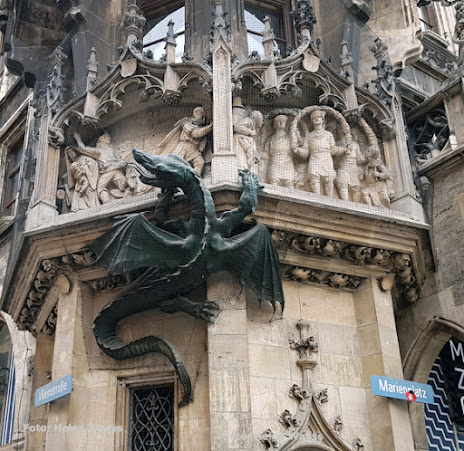Munich legend: The Lindworm and the Schäffler
What is the big lindworm doing at the new Munich town hall?
The “Wurmeck” at Marienplatz in Munich
Munich - Marienplatz. At the bottom right corner of the new town hall in Munich: where Weinstrasse flows into Marienplatz, you will find the "Wurmeck". So named after a Munich legend, which is told here in stone façade reliefs and a large bronze sculpture. - Say, these are believed truths that always contain a bit of history and are passed down through generations. -It is a lindworm that climbs up the neo-Gothic corner tower (the town hall was built in 1906).
 |
| Photo: Lindwurm at the Wurmeck of the Munich City Hall, Copyright: Helga Waess |
In Munich we know the Lindwurmstrasse, which winds from the old Peasants' War Church in Sendling to the Sendlinger Tor
Yes, the four-lane road winds its way towards the city center with poplar growth on the side. And there is a lindworm festival hidden in Walter Moer's book dragon stories.
But back to the town hall and the huge, hissing bronze dragon
...who is climbing over the foliage and trying to reach the shepherds dancing under donkey-back arches and the fleeing population. His mouth is open and you almost think you can hear him hissing - if it weren't for the murmuring city noises of the crowds of people streaming past - even in Corona times - in the heart of Munich, Marienplatz.
Two artist names are involved here: Anton Kaindl who modeled the shape for the dragon and Hygin Kiene who created the metal version of the bronze dragon.
Why is the winged wyvern trying to reach the three groups of people?
Those dancing barrel makers who don't seem to notice him at all? And those citizens of the city who run away with all their children? While farmhands and the population are ready to fight the dragon in another relief. They load a muzzle-loading gun reminiscent of the 17th century. - The reliefs come from the sculptors of Jakob Bradl and Franz Xaver Bernauer.
The plague in Munich
At the top of the tower we find the reason for the trouble, a so-called megaera. A devilish-looking, terrible creature, the symbol of the plague that once spread fear, illness and death in Munich.
Above, this illness is compared to a doctor, a shepherd and a musician. That hero of the ways and means knew how to defeat illnesses and those who gave people back confidence and courage to live through music and dancing cheerfulness.
The legend of the lindworm and the plague that was defeated in Munich
According to legend, a terrible lindworm came out of the earth right at Wurmeck and from there brought the plague to the city. It took time until the disease was defeated and no one dared to go out on the streets of Munich anymore due to the risk of infection and the long years of plague. The barrel makers, the so-called Schäfflers, had the brilliant idea of proclaiming victory over the plague through music and dance. They danced through the city. People took a deep breath and followed them, life in Munich could begin again.
But as is always the case with sayings:
The first Schäffler dance can only be documented around 1725. By the way, the Wurmeck was already mentioned in the documents in 1431.
 |
| Marienplatz with Christmas market in front of the New Town Hall in Munich, photo: Helga Waess |
